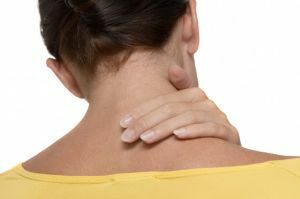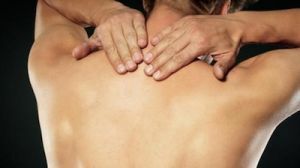 The vertebral artery is a pair formation, located between the clavicular artery and the 6 cervical vertebra.
The vertebral artery is a pair formation, located between the clavicular artery and the 6 cervical vertebra.
This vessel passes through the vertebrae of the neck and enters the skull along the occipital foramen.35% of the arterial blood enters the brain through these two arteries.
If they are pinched, then there is a cervical migraine( vertebral artery syndrome)( G99.2 for ICD 10).
Blood enters the posterior part of the brain: the trunk and posterior portion of the cortex. The fact that blood vessels enter the brain with this vessel can explain why the neck migraine has characteristic symptoms.
The entire length of the spinal artery contacts the soft tissues around the spinal column. That is why the mechanisms of the appearance of defeat differ.
Article Contents
- reasons
- Disorder Symptoms and signs of the syndrome
- The diagnosis
- How to treat cervical migraine
- Complications and consequences
- Prevention
reasons
disorder syndrome vertebral artery has specific reasons:
- Related to the spine - Vertebrogenic syndrome vertebral artery - observed from- dystrophic processes in the spine, injuries, scoliosis of the cervical spine.
- Non-vertebral- non-embryonic - are caused due to atherosclerosis, structural disorders or the location of these vessels.
Common causes of lesions:
- arthrosis of the joint between the 1st and 2nd vertebrae of the neck;
- anomaly of Kimmery;
- high location of the process of the cervical vertebra;
- non-standard branch of the artery of the spine from the clavicular vessel;
- spasm of the muscles of the neck.
Provoking conditions can be sharp turns, head inclinations. In this situation, there is a squeezing of the vessel - because of the existing disorders, the elasticity of the arterial wall is reduced.
Symptoms and symptoms of
Syndrome Symptoms and symptoms of
The disease has the following symptoms:
- Headache - burning, throbbing, the doctor may suspect defeat and prescribe medication with pain on one side, centered in the temple, crown and
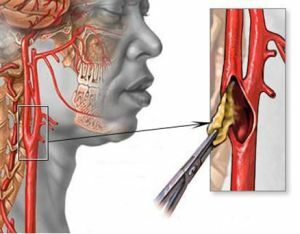 above the eyebrow. Pain can grow after sleep on the back, with the head thrown back, walking.
above the eyebrow. Pain can grow after sleep on the back, with the head thrown back, walking. - Nausea, vomiting, impaired consciousness - manifested after an unexpected change in the position of the head.
- Visual disturbances are an unexpected pain in the eyes, a transient decrease in visual acuity.
- Vestibular and auditory problems - hearing impairment on the one hand, dizziness, tinnitus.
- Cardiac and vascular deviations - angina pectoris, instability of pressure, an unexpected jump in blood pressure.
- Brain disorders are manifested by the principle of ischemic strokes of vertebral vessels.
If you find such symptoms, you should immediately call your doctor.
Symptoms of Barre Liu syndrome are similar to those of cerebral blood flow disorders.
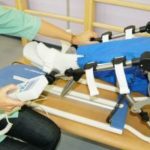 Restoring the motor activity of joints with the help of devices Artromot - types and use of devices.
Restoring the motor activity of joints with the help of devices Artromot - types and use of devices.
Osteocytes of the cervical spine can also cause vertebral artery syndrome - find out more.
Diagnosis of
Diagnosis of Bare Lieu syndrome involves the implementation of different examinations. First of all, it is based on the information that can be obtained from the clinical picture of the lesion: the patient's complaints, the information of the neurological examination.
Often, the diagnosis reveals the tension of the occipital muscles, difficulty in turning the head, pain at the pressure on the processes of the first and second cervical vertebrae.
Among other things, the is sure to be produced:
- X-ray of the cervical department .Here, the study is performed in several projections and helps to identify changes in the atlanto-occipital joint. Changes that provoke compression of the vertebral vessel are determined.
- Doppler examination of .This examination, conducted on vertebral vessels and allows to determine the difficulty of blood flow.
- Tomography of the brain is an obligatory procedure used for suspected ischemic stroke. It makes it possible to discover the cause that caused the lack of blood flow, as well as the place of squeezing the vessel. MRI of the spine is also performed, which allows to determine the lesions of the spinal column.
How to treat a cervical migraine
If a posterior cervical sympathetic syndrome is diagnosed, then treatment should start with finding the main cause.
Spine deviations should be treated, namely:
- disc protrusions;
- vertebral hernia;
- of osteochondrosis.
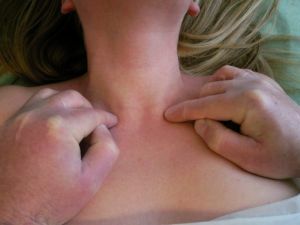 uses the combining approach to treat the disease, depending on the person's age, the severity of the condition and the characteristics of the body.
uses the combining approach to treat the disease, depending on the person's age, the severity of the condition and the characteristics of the body.
Due to the fact that those suffering from the disorder fall into the risk group for a stroke - the treatment is primarily aimed at neutralizing the causes of spasm and blood flow disorders, as well as for the speedy normalization of blood supply.
Before starting treatment with , a thorough examination of is required to find the exact cause of the deviation. Patients are immediately placed in the hospital if they suspect a violation of the blood supply to the brain.
Given the cause and degree of compression of the vessel, the specialist can designate:
- Use of the Shanz collar to relieve the burden from the cervical region. The tire is selected separately for each person.
- Manual therapy and massage. Before the beginning of manipulations it is required to undergo examination at the doctor, tk.there are contraindications for this method of treatment. Objectives of impact - restoring the position of parts of the spine.
- Acupuncture is extremely effective for pain reduction, neutralization of dizziness, heart pain.
- Physiotherapy includes magnetotherapy, electrophoresis, dynamic currents. After neutralizing the pain, a system of exercises is chosen for strengthening the muscles.
- Patients must use a special mattress and pillow.
- Drug treatment is aimed at treating a disorder that provoked the appearance of the syndrome. Patients are shown taking analgesics( ketorol, baralgin), non-steroidal anti-inflammatory drugs( movalis).Sometimes prescribed medications that restore cerebral blood flow( cinnarizine).
Such interventions are carried out in the conditions of a medical institution: osteophytes, any pathological formations are removed. Sympathectomy may also be performed.
Complications and consequences of
If the disease is not treated or improperly treated, then the vertebral artery syndrome can have severe consequences: 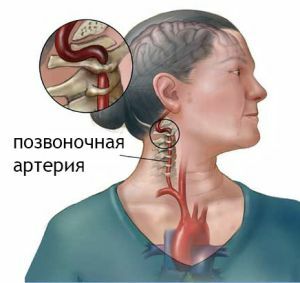
- Disturbance of blood circulation of parts of the brain. This initially causes only temporary neurologic abnormalities. They last up to a day and are called ischemic attack. If they are neglected, there can be a stroke, negative consequences for the heart, vision.
- A person who is often dizzy, , there are falls in the consciousness of , problems with coordination and balance, lack of ability to work, ability to self-service. Stroke does not always become the result of a violation, but disability is frequent.
Prevention
Warning measures:
- doing gymnastics for the neck and shoulder girdle;
- sleep on a special cushion;
- pass neck massage once every six months;
- treatment in neurological sanatoriums.


